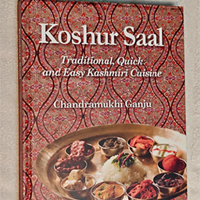Koshur Saal: Traditional, Quick and Easy Kashmiri Cuisine -Full-Color Edition

In our multicultural world, few joys compare to sharing diverse foods at the table. This book celebrates that delight through the rich and aromatic cuisine of Kashmir, India’s northernmost region known for its unique culinary heritage. It features flavorful recipes, many with healthier alternatives to deep frying, proving that Kashmiri cooking can be quick, fun, and done in just 10 to 25 minutes. The dishes stand apart from the rest of India with their bold, spicy character and distinct style.
Beyond recipes, the book highlights the health benefits of everyday foods and explains the cultural and religious significance behind Kashmiri traditions. Koshur Saal (“Kashmiri Feast”) has long been cherished by home cooks, food lovers, and cultural enthusiasts. This new edition goes a step further by reviving forgotten dishes and preserving them for future generations.
 “This book is more than recipes—it’s a heritage volume for the global Kashmiri diaspora, a way to reconnect with tradition and identity through food,” says author Chandramukhi Ganju.
“This book is more than recipes—it’s a heritage volume for the global Kashmiri diaspora, a way to reconnect with tradition and identity through food,” says author Chandramukhi Ganju.
Readers agree. Kartikeya Tanna, who gave it 5 stars and called it the “Best ever Kashmiri Pandit cookbook,” writes:
“Best Kashmiri cookbook with easy everyday recipes. Simple to follow, with cultural and religious insights. I recommend it to everyone.”
Another reviewer, Walter J. Campbell, also rated it 5 stars, calling it “one of the best recipe books on the market.” He adds:
“I tried a few dishes and they turned out excellent. The best part is the simplicity—you could become a chef just by following this book.”
Extract from the book with the permission from the Author
“White rice is the staple food that balances the spicy hot Kashmiri dishes.
Some of the dishes have a cultural as well as a religious background and hence are prepared on special occasions. I have tried to indicate at the appropriate places the necessary information in this regard. Quantities of spices specified in recipes are merely a guide. So, feel free to experiment and adjust these as per your liking. In general, chilies and salt are the two ingredients that can be varied according to personal taste.”
“Deeply concerned at the fact that future generations of diasporal Kashmiris might lose touch with authentic Kashmiri cuisine, as they do with their native language, it occurred to me that I must pass on the recipes learned by me from my mother, Prabha Pandita, to the generations to come.”
About the Author:
ChandraMukhi Ganju’s journey of cultural preservation began after the Kashmiri Hindu exodus of the early 1990s. Forced to leave her homeland in 1993 due to escalating terrorism, she rebuilt her life in the United States with one urgent concern—that Kashmiri language, cuisine, and traditions might fade with time and distance. Instead of accepting that loss, she transformed her worry into action.
Believing that food is memory, identity, and heritage on a plate, she began documenting and sharing traditional Kashmiri recipes. She created koshursaal.com, one of the first online platforms devoted to Kashmiri cuisine and culture. The enthusiastic global response encouraged her to expand her mission.
In 2009, she published Koshur Saal, an authentic cookbook that goes beyond ingredients and methods. It preserves the cultural and spiritual meaning behind traditional dishes and introduces them to younger generations and non-Kashmiris alike. Now headed into its third edition, the book revives recipes that had quietly disappeared from daily kitchens, offering both nostalgia and preservation.
ChandraMukhi also became the first Kashmiri food blogger on YouTube, sharing monthly recipe videos through Shehjar magazine. Her work has inspired the diaspora and sparked new interest among youth who may never have seen these dishes prepared at home.
To her, cooking is an art and an experience. She believes that a peaceful, intentional kitchen infuses meals with positive energy that nourishes both the body and family ties.
Her cultural commitment extends beyond food—she also writes plays in the Kashmiri language to keep the spoken tradition alive.
Through storytelling, culinary revival, and creative outreach, ChandraMukhi Ganju has become a custodian of heritage—ensuring that Kashmiri culture is not just remembered, but shared, celebrated, and savored across generations.




























